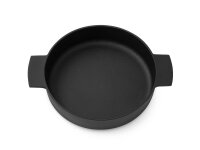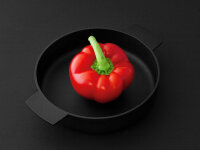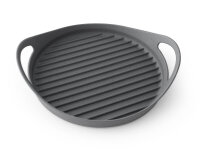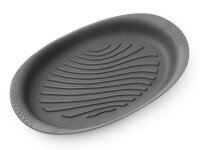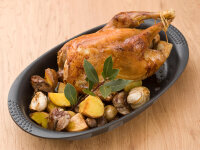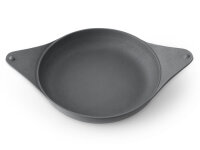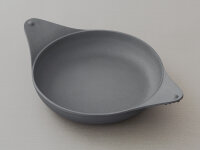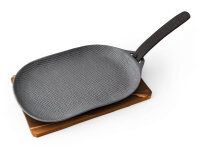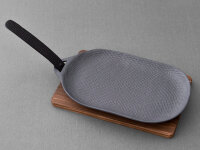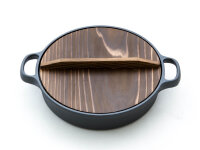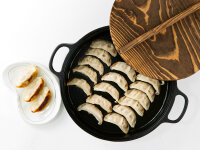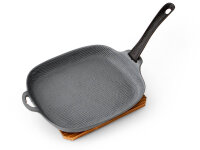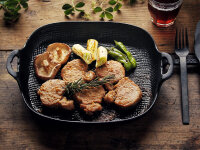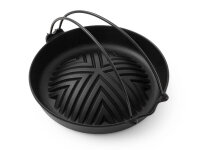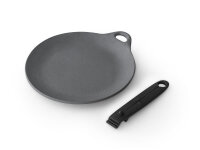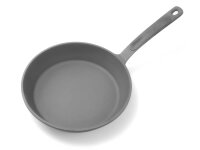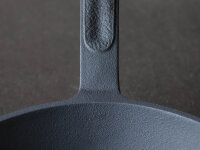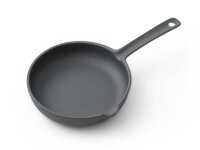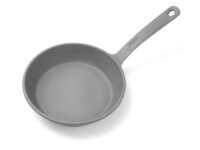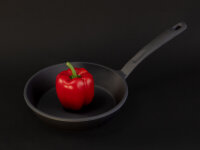
Cast Iron Pans Variety
Why a Cast Iron Pan? It's Simple: Cooking is a Matter of Good Taste
Those who enjoy cooking generally appreciate good food. And what is good food? It should be healthy. It should look appetizing. But above all, it should taste good. Taste is - by one definition - what one perceives when eating and drinking. Like hardly any other cookware, a cast iron pan can enhance the taste of your dish. Whether it's vegetables, fish, or meat, anyone who has prepared their favorite dish in a cast iron frying pan will not want to give up the cast iron pan. It's no wonder that cast iron pans have been experiencing a true renaissance in professional kitchens for years. After all, cooking in professional kitchens involves all sorts of refinements, and the home kitchen definitely has nothing to hide.
Why is it that both professionals and experienced home cooks believe that food tastes better when cooked in cast iron pans? Responsible for the enhanced flavor are the material of the cast pan and the manufacturing technique. Cast iron frying pans and cast iron pots are made from an alloy containing 3 - 5% carbon and 1 - 3% silicon.
In comparison, wrought iron has less than 1% carbon. Cookware made of cast iron is hardly mechanically processed after casting, unlike wrought iron. Therefore, carbon in cast iron exists as graphite, which is practically readily available, at least when cast iron pans are not coated and thus sealed. It can be assumed that wrought iron pans primarily enhance the taste by developing a patina through seasoning the pan and regular use.
Because forging "seals" the material. In the case of cast iron pans, however, the material also contributes to the flavor. The consensus among chefs, as far as we can see, is unanimous: both the inherent flavor is enhanced, as well as the development of searing flavors, making the taste richer and closer to grilled food.
The Eye Cooks Along
Taste is not only about what you taste. A good taste also includes the ability to distinguish between beautiful and "less beautiful" things. Beauty is famously in the eye of the beholder, and everyone should judge for themselves what they like best.
We follow the same approach when selecting our range. Quality comes first, and aesthetics come after. Whether the new cast iron pan, cast iron roaster, wok, braising pot, or service pot is used frequently, placed on the dining table, and used with love and attention is influenced by both function and design. Some of our cast iron cookware has won prestigious design awards, while others have simply convinced us visually, and still others are so unusual that we simply couldn't say no. Trust your good taste when making your selection; a sustainable product is only truly good when it is taken out and used often.
Criteria for selecting a non-coated cast iron pan:
- Material, Raw Material - for your health
- Processing, Manufacturer - for sustainability and longevity
- Cooking habits, e.g., use in the oven - for your flexibility
- Design - for your pleasure
Not All Cast Iron Pans Are the Same
Nanbu Tekki is a traditional method for producing cast iron products. The history of Nanbu Tekki dates back to the 17th century. Its origin is the city of Morioka in the Iwate Prefecture, high in the north of Japan. To promote the development of the region, the 27th king of the Nanbu clan laid the foundation for various crafts, including Nanbu Tekki, by building a castle. The abundance of natural resources in the area further established Iwate as a center for Nanbu ironware production.
Today, the Nanbu Tekki method is used to produce a wide range of different products. The most important ones include Tetsubin, the Japanese iron kettle, used for heating water. Tea pots and various utensils for tea ceremonies are also part of the Nanbu product portfolio. Of increasing importance is the field of cookware, ranging from the cast iron frying pan, the cast iron pot, to specialized cookware such as the wok pan, the rice pot, and even unusual items like a Genghis Khan pan. Nanbu Tekki products also include meditative wind chimes, containers for incense and aromatic sticks, and many other items.
What sets this traditional Nanbu Tekki method apart, and why is it highly regarded in Japan and among connoisseurs? One of the outstanding features and clear distinctions from other methods of manufacturing cast iron products is that Nanbu Tekki allows for the production of products with exceptionally thin wall thicknesses. Thinner than with any other method worldwide. What are the advantages of this?
Firstly, more delicate and intricate shapes and patterns are possible. Additional advantages include reduced weight and shorter, energy-saving heating phases. The approximately 30 - 40% lower mass notably contributes to kitchen work. The next advantage primarily concerns maintenance: the surface finish of masterfully crafted Japanese cast iron pans and cast iron pots is not only beautiful and smooth but also provides special protection.
Debunking the Myth of High Maintenance
We often read about cast iron cookware in connection with phrases like, "Yes, but...!" The allegedly high maintenance seems to deter some people from buying a cast iron pan, a grill pan, or a cast iron pot. The care recommendations provided by manufacturers Iwachu and Kamasada, which practically align with the recommendations of other manufacturers like Le Creuset or Skeppshult pans, seem in stark contrast to the fears of minimal effort.
Please note that here we are referring to a cast iron frying pan that is uncoated and properly seasoned. After cooking, the pan is cleaned by removing any remaining food residues, washing the cast iron pan with hot water - without detergent if necessary - drying it with a kitchen towel or absorbent paper, adding a few drops of oil, and spreading it. Done. Those are the recommendations, but what does practice look like? We can share personal experiences with our cast iron roaster, Sukiyaki cast iron pan, grill pan, and cast iron pot. Our personal impression is also shaped by past experiences with other pans. In the past, there was often some serious scrubbing involved.
That is, when something went wrong while frying and it got burned or when the less attractive burnt grease splatters on the "bare" metal surfaces were annoying, steel wool, a lot of patience, and some muscle power were often required. For non-stick Teflon pans, such a big effort was relatively rare because the pan - not very sustainable - had a relatively short lifespan. Now, comparing the maintenance effort for cast iron pans and, by the way, for wrought iron pans that we still use: We've never had anything burn while frying.
This could be due to increased attention. A practical tip: If we haven't made any sauce, we wipe the pan with a piece of kitchen paper after it has cooled down a bit, add a few drops of oil, and spread it with the same paper. Done. If we made sauce, we wash the cast iron pan with hot water, use kitchen paper to dry it, add a few drops of oil, spread it - on the bottom and on the edges - and we're done. Time spent: 1 - 2 minutes.
Caring for cast iron pans:
- One-time: Season cast iron pans - follow our guide: Season Cast Iron Pans »
- Clean with cloth or kitchen paper. Rinse with hot water if needed.
- Optionally, dry the pan.
- Spread some oil in the warm pan.
How Many Cast Iron Pans Does a Person Need?
Of course, it depends on your cooking habits and your desires regarding the results. However, with a few fundamental considerations, you can go a long way. What do you want to prepare? How should the desired taste experience be?
Desires: Cast iron pans fundamentally allow for richer, fuller flavors. In our experience, the flavors are even more intense than from wrought iron frying pans. And with a bit of practice, they are easier to handle.
Energy: High-quality cast iron pans have excellent heat conductivity and also retain heat very well. For longer cooking or frying times, they help save energy. For very short cooking or frying times, very heavy pans require more energy because they take longer to heat up.
Heat Distribution: High-quality cast iron frying pans are equally hot across the entire surface. This fact makes work easier for both professionals and amateur chefs. However, it is important to choose an adequately sized heat source.
Dishes That Are Perfect for Cast Iron Pans:
Braised dishes, flavorful vegetables, tender meat, delicious sauces. Basic approach: Sear, deglaze, let simmer. On the stove or in the oven. For delicious braised dishes, we recommend using a cast iron roaster or a cast iron pot. Both can be safely placed in the hot oven after searing.
Roasts, delicious fillet roasts, hearty game roasts, fine roast beef, poultry, or even vegetarian roasts, as long as a baking dish is not required. Sear, place in the oven, let it cool in the oven after the cooking time, gently let it finish cooking (at around 80°C). For such dishes, we recommend the roaster - without the lid - or of course, the cast iron pans without a wooden handle, especially the Sukiyaki pans, as they fit perfectly in the oven.
Quick searing, steaks, schnitzels (including poultry), chops, medallions, vegetables. Also vegetable or rice pans. Quickly sear at relatively high temperatures, fry a bit longer at lower temperatures if necessary, and let it finish cooking gently. For pan dishes, a cast iron wok or the Sukiyaki pan is ideal. For flat meat or vegetable slices, use the steak pans.
Frying Pan Sizes:
What pan sizes do you really need? A difficult topic that is hard to answer without knowing individual habits. Generally, larger frying pans are bought and used. The advantage of smaller pans is clear: easier handling and less energy consumption. For a versatile kitchen, the following combinations are conceivable:
Basic equipment:
- A larger cast iron frying pan for main dishes
- A smaller cast iron pan for preparing "ingredients" separately
- A cast iron roaster or pot
Good Additions:
- Fish Pan (cast iron, oval pan)
- Steak Pan (for those who love to sear flat meat and vegetables decoratively)
- A Cast Iron Wok or a Wok Pan for lovers of Asian rice and noodle dishes
- Pancake/Omelet Pan (you will be surprised)
Cast Iron Pan or Wrought Iron Pan: Similarities but also Important Differences
Both are iron pans, and in our opinion, they are a better choice for most applications compared to aluminum or stainless steel pans. Copper pans are a certain exception, but they also have some disadvantages and are mainly suitable for sauces.
Another hot topic is whether a coated pan or an uncoated pan is better. We have a clear opinion on this, which not everyone may share: When the base material is suitable and offers some advantages, a coating is often a compromise.
We are very critical of plastic non-stick coatings because they can produce dangerous fumes at higher temperatures and due to mechanical damage. Both wrought iron pans and especially cast iron pans can easily develop a natural non-stick coating that works perfectly, is healthier, and can withstand high heat.
Flexibility, Types of Stoves
Iron pans are also suitable for induction stoves. Both types. They can be used in the oven, on gas, electric stoves, and on the grill as long as there are no flammable parts.
Flavor
As mentioned above, flavors seem to develop better in iron pans than in other pans, according to our experience. The highest intensity was observed with cast iron pans. Those who love intense flavors will be best served with cast iron pans.
Heat Conductivity and Uniformity
According to our information, cast iron pans have higher heat conductivity. Only copper pans could be better. However, they require more maintenance and are usually coated.
Heat Retention
Here, the cast iron pan clearly has the advantage over the wrought iron pan. It allows you to save energy and keep food warm better.
Cleaning
Both iron pans can be cleaned without any chemicals, and it is not only possible but also hygienic.
Risk of Burning
Both iron pans are seasoned (seasoning iron pans), and they develop a patina. Our personal experience is that these pans offer certain advantages due to their porous material: you need less fat, and we haven't had anything burn yet.
Weight
Wrought iron pans are somewhat lighter than the usual cast iron pans. However, Oryoki's cast iron pans, all of which are made using the Nanbu Tekki method, can compete in terms of weight. We have found wrought iron pans with the same diameter but higher weight.
Lifespan
Cast iron pans have a practically unlimited lifespan with correct use. They can theoretically break if they fall from a significant height onto a hard surface, which would be considered improper use. Poorly cast cast iron pans - a risk with cheap products - can also warp if cast under residual stress. With our quality products, we can definitively rule this out if the operating instructions are followed.
Pros and Cons of Frying Pans Made of Other Materials
Copper Pans
Light and excellent heat conductivity. Unfortunately, they are mostly coated, sometimes with plastic. Expensive and high maintenance. Usually not suitable for induction stoves. Often not suitable for high temperatures.
Steel or Cast Iron Pan with Enamel Coating (Enameled Cast Iron)
Often suitable for relatively high heat, although we have also read about problems. The non-stick effect is generally mediocre to poor. Scratch-resistant and relatively easy to clean. Allergics (nickel) can use these frying pans comfortably.
Stainless Steel Pans
Suitable for high heat and strong searing. However, they require a lot of fat, and many things tend to stick easily. Cleaning - especially after a burning incident - is extremely laborious. While pure stainless steel can retain heat, its heat conductivity is rather poor. Pans with ceramic coatings are better.
Aluminum Frying Pans
Light and good heat conductivity. We consider uncoated aluminum frying pans to be problematic - you may need to find out how much aluminum can be released into the food. Coated aluminum pans depend on the coating, but they are usually unsuitable for high-temperature searing. Only ceramic-coated frying pans can withstand high heat.
How Healthy is Cooking with a Cast Iron Pan?
The key to healthy eating is the conscious selection of foods. This is a task that cannot be accomplished without attention. However, it is also a growing need in the modern world. Every "food scandal" awakens more people and promotes a critical view. There is also a lot of information available on healthy food preparation, and some cherished habits suddenly come into question. Think of "grilling" and "aluminum."
So, what about health in relation to cookware and cast iron? Is it healthy to cook with cast iron pans, and is a cast iron pot the right choice for health-conscious people? It's clear that "it depends," but what does it depend on? We at Oryoki are not objective, as we have consciously decided to offer cookware made of cast iron in our shop. Therefore, please consider everything we write here as guidance and by no means as health advice.
What common sense tells us is this: "Only if there is nothing harmful in it, can it be healthy." This applies not only to food but also to everything I use in the kitchen. A cast iron pan can only be beneficial to your health if the cast iron it is made of is of high quality. Base metals - we don't want to accuse anyone, but we have read about it - have no place in cast iron pans or pots. "Cheap" has one or more reasons, but a high price does not automatically mean "top quality." Here's why we trust our partners:
- There are rich deposits of natural iron ore in the immediate vicinity of the production site.
- All partners have a long tradition and a good reputation, two of them worldwide.
- The partners regularly have the raw materials tested.
- In a high-wage country like Japan, especially in a time-consuming and labor-intensive production process, the price of raw materials plays a minor role, so it has little weight. It's different with cheap products from low-wage countries.
- Our partners in Japan rely on their good reputation. Losing a good reputation in Japan means downfall.
- Even intensive research has not raised doubts about the credibility of the manufacturers and the high quality of the products.
The raw material is one point to check. Another point is what happens when food, heat, and cast iron come together. When cooking in cast iron pans or a cast iron pot, the cast iron can release iron and - with long cooking times and acidic ingredients - minerals into the food. The iron is bivalent iron, which is more easily absorbed by the human body than iron from plants. There is a study by Texas Tech University for Food & Nutrition on this.
Is this healthy? Again, it depends. Too little iron is unhealthy and is probably widespread. This means that cooking with a cast iron pan or a pot can help mitigate iron deficiency. Children and adolescents in the growth phase, especially women, are frequently affected by iron deficiency according to various reports. Blood loss is generally associated with iron loss, so strong, regular bleeding can be a cause of deficiency. However, vegetarians and vegans also struggle with the problem. While they often focus on particularly iron-rich foods, the trivalent iron from plants, including legumes, is poorly absorbed.
We ourselves assume, without being scientists, that cooking with cast iron is healthier than taking too many supplements (dietary supplements) indiscriminately. However, there are also cases of iron overdose, often caused by supplements. In this case, we recommend consulting a trusted doctor or pharmacist and being particularly cautious when choosing industrially produced foods, as they may be enriched with - probably artificial - iron. In general, based on everything we have read, we can probably assume the following rules, but in case of doubt, always consult your doctor:
- Normal iron levels: The cast iron pan / cast iron pot helps prevent a deficiency
- Too low iron levels: Cast iron helps counteract the deficiency (regular checks are advisable)
- Too high iron levels: please consult a doctor

